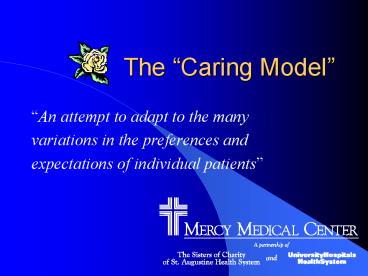The Caring Model - PowerPoint PPT Presentation
1 / 22
Title:
The Caring Model
Description:
Compare differences in nurse and patient definitions of caring ... Satisfaction with the nurse-patient relationship and the hospital experience is ... – PowerPoint PPT presentation
Number of Views:250
Avg rating:3.0/5.0
Title: The Caring Model
1
The Caring Model
- An attempt to adapt to the many
- variations in the preferences and
- expectations of individual patients
2
Objectives
- Identify environmental forces driving a renewed
emphasis on caring - Compare differences in nurse and patient
definitions of caring - Develop an understanding of the patient
experience - Apply caring behaviors to practice
3
Todays Emphasis on Caring
To flourish in this competitive environment,
institutions must incorporate patient and family
expectations of quality care into the care
experience.
Ludwig-Beymer, Ryan, Johnson, Hennessey,
Gattuso, Epsom Czurylo, 1993
4
Todays Emphasis on Caring
Customer responsible organizations who
focus on giving consumer convenience,
control, support, and information will
have a competitive advantage through improved qu
ality and controlled cost.
Herzienger, 1997
5
Patient Satisfaction
Patient satisfaction and willingness to
recommend the provider can be increased
by providing information, convenience,
and interpersonal warmth . . .
which are characteristics other than price and
technical quality of care that patients value.
Peyrot, Cooper Schnapf, 1993
6
Patient Satisfaction
Patient satisfaction has become an established
indicator of quality care, as well as a central
theme in highly competitive health care environm
ents. Those providers who can establish market d
ifferentiation based on service quality
will continue to grow and survive
in the 21st century.
Davis Adams-Greenly, 1994
Mahon, 1996
7
Patient Satisfaction
Patient satisfaction is a complex mixture of
perceived need, expectations of care,
and the experience of care.
Greeneich, Long, Miller, 1994
8
Patient Satisfaction
- Patient reaction to and satisfaction with nursing
care is the most important predictor of overall
satisfaction with hospital care.
Williams, 1997
9
Patient Satisfaction
- Patient satisfaction is related to the ordinary
human virtues of communication, sensitivity,
respect, dependability, trust, and personalized
service.
McDaniel Nash, 1992
10
Patient Satisfaction
- Satisfaction with nursing care is largely based
on the perceptions of the nurses affective
behavior toward the patient.
Donabedian, 1988
11
Our Mission
To continue Christs healing ministry by
providing quality, compassionate care for the
whole person.
12
Catholic Healthcare Directives
13
Caring Experiences
Remember a caring experience in which you were
the nurse or the patient. Write a brief descript
ion of the experience.
14
Caring Characteristics
- Caring Person
- Somehow responsive to person as a unique
individual. - Perceives the others feelings.
- Sets apart one person from another from the
ordinary.
- Uncaring Person
- Insensitive to another person as a unique
individual. - Non-perceptive of the others feelings.
- Does not necessarily distinguish one person from
another in any significant way.
Watson, 1985
15
Getting it All
How do we reconcile the needs of patients for
caring and the demands of payers for
ever-increasing levels of productivity and
cost-containment?
16
Why I Became a Nurse?
17
We need to love, respect, care for ourselves,
and treat ourselves with dignity, before we
can respect, love, and care for others and treat
them with dignity.
18
Patients and caregivers come to the relationship
with perconceived notions or stereotypes
that can help or hinder a caring interaction.
Another Nurse Ratchet!
What a whiner!
19
If you treat man as he appears to be, you
make him worse than he is. But if you treat man
as if he already were what he potentially could
be, you make him what he should be.
--Goethe
20
Critical Juncture
- A vulnerable period in a patients hospital
stay. - Events create the most lasting impression during
a critical juncture. - Satisfaction with the nurse-patient relationship
and the hospital experience is often defined
during a critical juncture.
21
- Patients are more apt to forgive an unfortunate
outcome than to forgive lack of concern and lack
of communication.
Fiesta, 1994
22
Patients and Nurses Define Caring Differently
- Nurses
- Listening
- Offering comfort
- Putting the patient first
- Talking to the patient
- Responding quickly to call lights
- Patients
- Accessible and able to teach
- Monitor condition closely
- Follow through with promises
- Sensitivity to patient autonomy
- Recognition of individual qualities and needs































